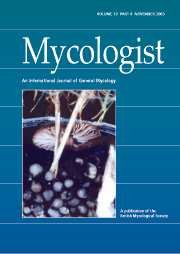Article contents
Water availability and metabolomic profiles of Epicoccum nigrum and Sarophorum palmicola grown in solid substrate fermentation systems
Published online by Cambridge University Press: 18 March 2005
Abstract
There has been interest in using environmental screening procedures for enhancing the metabolomic production profiles by fungi which are of pharmaceutical interest. This study examined two ecologically distinct species, Epicoccum nigrum and Sarophorum palmicola, in solid substrate fermentation systems over a range of water availability conditions (water activity, aW). Total secondary metabolite profiles were obtained by HPLC + diode array detection after 14 days incubation on cereal-based substrates in relation to four aW treatments. Temporal studies (24 d, E. nigrum and 18 d, S. palmicola) showed that metabolite production profiles varied markedly between the two fungi. For E. nigrum, metabolite production generally increased with reduction in aW, and was optimal in the range 0.99 - 0.97. In contrast to this, for S. palmicola, metabolite production was restricted to the highest aW level used, 0.998, and declined to zero at 0.99 aW. Statistical analysis revealed that time, aW and their interactions were significant in all cases (p<0.001). The potential for using ecophysiological stresses for enhancing natural product discovery is discussed.
- Type
- Original Article
- Information
- Copyright
- © 2005 Cambridge University Press
- 4
- Cited by




